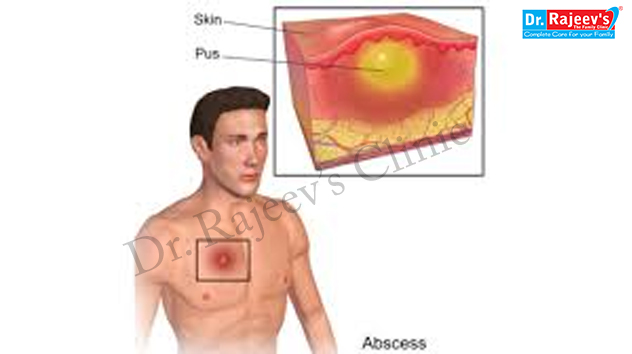

An abscess is a place of accumulation of the creamy white, yellow, or greenish fluid, known as pus, surrounded by reddened tissue. It is the result of the body's inflammatory response to a foreign body or a bacterial, viral, parasitic, or fungal infection. An abscess usually dries out and resolves when it is drained of pus. Most abscesses are septic, which means they are the result of an infection. Abscesses occur when white blood cells (WBCs) gather in response to an infection. They produce oxidants (for example, superoxide radical) and enzymes to digest the invading bacteria, viruses, parasites, or fungi. The infective agents are then broken down by the WBCs into small pieces that can be transported through the bloodstream and eliminated.

The face, armpits, arms and legs, rectum, sebaceous glands (oil glands), and the breast during lactation.
Lung abscess. During or after pneumonia, an abscess can develop as a complication.
Abscess is essentially caused by infection, largely bacterial infection. It can also be caused by parasite infection. An abscess may be caused or triggered by a foreign body or physical trauma or injury.
Symptoms of an abscess are the general signs of inflammation. Symptoms that identify superficial abscesses include heat, redness, swelling, and pain over the affected area. Abscesses in other places may produce only generalized symptoms, such as fever and discomfort. A sterile abscess may present as painful lump deep under the site of an injection. A severe infection may bring on fever, fatigue, weight loss, and chills. Recurrent abscesses may indicate undiscovered allergies or decreased immune functioning.

A general physical examination and a detailed patient history are used to diagnose an abscess. Recent or chronic disease or dysfunction in an organ suggests it may be the site of an abscess. Pain and tenderness on physical examination are common findings. There may also be a leakage of pus from a sinus tract connected to an abscess deep in the body tissue.
Conventional treatment: Abscess due to bacterial infection respond to antibiotics. In case of un-ruptured pocket of pus, drainage may be required.
Tea tree oil (Melaleuca spp.) and garlic (Allium sativa) directly applied to abscesses may also help to clear them.
Applications of a hot compress to the skin over the abscess will hasten the draining or the reabsorption of the abscess. Contrast hydrotherapy, using alternating hot and cold compresses, can also be used. Additionally, localized warm/hot soaks three to five times daily frequently brings an abscess to heal.
Acute abscess of recent origin can respond to homeopathic medicines; however, it may take little longer than antibiotics.
Homeopathy is strongly indicated for recurring and resistant cases of abscesses.
Belladonna- Is the remedy most often indicated for the initiatory symptoms of abscess. The parts swell rapidly, become bright red, there is intense throbbing which is painful,pus develops speedily the swelling increases and the redness radiates;
Hepar sulphur – Is the great homoeopathic remedy for suppurations where the pus is not decomposed. There is excessive sensitiveness of the parts is a leading indication. It is further indicated by these symptoms: chilly sensations, throbbing in the parts, or sharp, sticking pains which are worse at night and from If given low in threatening suppuration it will favor the formation of pus. The suppurative process will often be aborted by Hepar if given in the higher potencies.
Silicea – Is the remedy where the suppuration continues and the wound refuses to heal, no matter where the suppurative process is located; the pus is apt to be thin,watery,and the process is sluggish and indolent one
Mercurius – It favors the formation of pus especially in the lower potencies, and is especially indicated in glandular abscesses; the pus is greenish in tint, and quite thin and fluid. There is intense, shining redness with throbbing and stinging pains. It does not follow Silicea well.
RL-22